

Ancient Egypt. Mesopotamia Art History from Goodbye-Art Academy. Ancient Egypt. Ancient Near East Art and Architecture - IMAGES. Mesopotamia Art History from Goodbye-Art Academy. Ancient Mesopotamia. Ancient Near East 7,000 to 330 BC. Ancient Near East 7,000 to 330 BC. Prehistoric Europeans. People Who Invented Art. Nude Woman (Venus of Willendorf), c. 28,000-25,000 B.C.E. Prehistoric Art - Cave Painting and Sculpture 30,000 to 15,000 BC. The Ancient Japanese. Jomon Period: 10,000 B.C. – 400 BC Stable living patterns began to appear in Japan with the arrival of the Jomon people around 10,000 B.C.
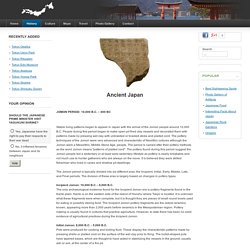
People during this period began to make open-pit fired clay vessels and decorated them with patterns made by pressing wet clay with unbraided or braided sticks and plaited cord. The Ancient Japanese. Timeline Of Ancient Japan. Ancient Japan. By Tim Lambert The First Japanese Human beings have lived in Japan for at least 30,000 years.
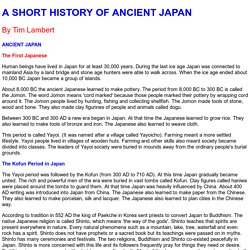
During the last ice age Japan was connected to mainland Asia by a land bridge and stone age hunters were able to walk across. Ancient Japan. Japan - Ancient Cultures. On the basis of archaeological finds, it has been postulated that hominid activity in Japan may date as early as 200,000 B.C., when the islands were connected to the Asian mainland.

Although some scholars doubt this early date for habitation, most agree that by around 40,000 B.C. glaciation had reconnected the islands with the mainland. Based on archaeological evidence, they also agree that by between 35,000 and 30,000 B.C. Homo sapiens had migrated to the islands from eastern and southeastern Asia and had well-established patterns of hunting and gathering and stone toolmaking . Stone tools, inhabitation sites, and human fossils from this period have been found throughout all the islands of Japan. More stable living patterns gave rise by around 10,000 B.C. to a Neolithic or, as some scholars argue, Mesolithic culture. Japan - Ancient Cultures. Japanese History - Facts About Japan - Ancient Japan. The four islands that make up the Japanese archipelago have been inhabited by humans for at least 30,000 years—though some theories suggest the area was populated as long as 200,000 years ago!

If you don't have time to digest the history of Japan (and unless you're a scholar or a speed reader you probably don't) you should at least familiarize yourself with some of the basic facts about Japan before embarking on your journey. Understanding the facts about Japan can only add another layer of meaning to the temples, parks, religious ceremonies and cultural wonders you are bound to encounter during your visit. What follows, then, is a cursory look at Japanese history, a jumping off point for further study about the history of Japan, and a quick reference for a few key facts about Japan.
Japanese Feudalism and European Feudalism. Although Japan and Europe did not have any direct contact with one another during the medieval and early modern periods, they independently developed very similar socio-political systems.
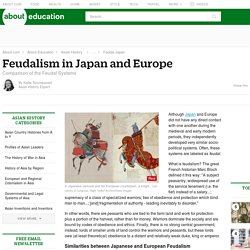
Often, these systems are labeled as feudal. What is feudalism? The great French historian Marc Bloch defined it this way: "A subject peasantry; widespread use of the service tenement (i.e. the fief) instead of a salary...; supremacy of a class of specialized warriors; ties of obedience and protection which bind man to man...; [and] fragmentation of authority - leading inevitably to disorder. " In other words, there are peasants who are tied to the farm land and work for protection plus a portion of the harvest, rather than for money.
Geography of Japan. Japan's Mysterious Pyramids. Early History and Culture. One of the most recognizable remnants of Japan's so-called "Tomb period" is the tomb of Emperor Nintoku, who is said to have reigned during the 4th century.
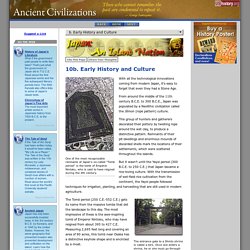
With all the technological innovations coming from modern Japan, it's easy to forget that even they had a Stone Age. From around the middle of the 11th century B.C.E. to 300 B.C.E., Japan was populated by a Neolithic civilization called the Jômon (rope pattern) culture. This group of hunters and gatherers decorated their pottery by twisting rope around the wet clay, to produce a distinctive pattern. Women in Ancient Japan: From Matriarchal Antiquity to Acquiescent Confinement. The role of women in ancient Japan elicits inconsistencies due to different influences that were integrated at various time periods.
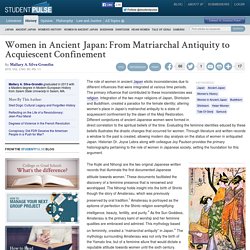
The primary influence that contributed to these inconsistencies was religion. Ancient Japan - The Ancient Japanese Empire. The Geisha, the traditional Japanese ideal of beauty Where did the Japanese come from?
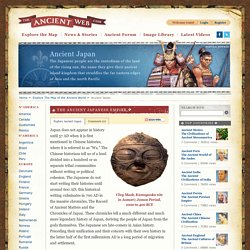
Why did they settle the islands? What did life look like before history was written down? In order to get a handle on ancient Japanese history, it helps to consider that it is driven by outside influences. Ancient Japan - The Ancient Japanese Empire. Italy’s Oldest Ruins: 5 Fascinating Prehistoric Sites. One destination for prehistoric sites in Italy: Matera The archaeological sites in Pompeii and Rome are fascinating—but they’re hardly the oldest ancient ruins in Italy.

If you want to see some ruins that are really old (we’re talking all the way back to the 8th millennium B.C.), fascinating, and off the beaten path, read on. Here are 5 of our favorite prehistoric sites in Italy! Ancient China for Kids. Timelapses from the Silk Road. Ancient China - The Ancient Chinese Civilization. Chinese Historical Accounts the Forbidden City, the home of the Chinese emperors until the last dynasty was overthrown in the 20th century Chinese history, until the twentieth century, was written mostly by members of the ruling scholar-official class and was meant to provide the ruler with precedents to guide or justify his policies.
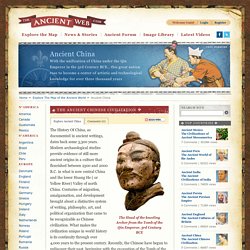
These accounts focused on dynastic politics and colorful court histories and included developments among the commoners only as backdrops. The historians described a Chinese political pattern of dynasties, one following another in a cycle of ascent, achievement, decay, and rebirth under a new family. Search. Ancient China Life History Facts:Dynasties,Discoveries,Religions,Crossbow,Sports,Chopsticks.
Chinese Dynasty Guide - The Art of Asia - History and Maps. Chinese history, which dates back more than 5,000 years, is extraordinarily rich, complex-and potentially confusing. Understanding at least its basic chronology and some of its most notable events and developments is made somewhat easier by virtue of its ancient system of dynasties. The word dynasty means, quite simply, a succession of rulers from the same family.
Chinese History - Common Core. From at least 1766BCE to the twentieth century of the Common Era, China was ruled by dynasties. A dynasty is a family that passes control from one generation to the next. A dynasty does not have to last for a long time. One Chinese dynasty lasted more than 800 years while another lasted only fifteen years. advertisement The ancient Chinese believed their ancestors in heaven had chosen their leaders. Zhou Dynasty, Zhou Dynasty History, History of Ancient China, China's dynasties. Era Information Time: 1027 B.C.-221B.C.Location of Capital:Hao, near the city of Xian, Shannxi ProvinceEmperors: Twelve kings for eleven dynasties Replaced by:Spring and Autumn Period According to Chinese accounts, Zhou was built by a chieftain of a tribe called Zhou.
The chieftain overthrew Shang’s last ruler and build the Zhou dynasty. He settled down in Hao, a city near today’s Xi’an city in Shannxi province. Take a Xian Tours to experience the historical site. Zhou dynasty has lasted for a long time from 1027B.C. to 221B.C. What is the Mandate of Heaven in China? Answer: The "Mandate of Heaven" is an ancient Chinese philosophical concept, which originated during the Zhou Dynasty (1046-256 BCE). The Mandate determines whether an emperor of China is sufficiently virtuous to rule; if he does not fulfill his obligations as emperor, then he loses the Mandate and thus the right to be emperor.
There are four principles to the Mandate:1) Heaven grants the emperor the right to rule,2) Since there is only one Heaven, there can only be one emperor at any given time,3) The emperor's virtue determines his right to rule, and,4) No one dynasty has a permanent right to rule. Signs that a particular ruler had lost the Mandate of Heaven included peasant uprisings, invasions by foreign troops, drought, famine, floods and earthquakes. Of course, drought or floods often led to famine, which in turn caused peasant uprisings, so these factors were often interrelated. Infobase. Most of the laws of Ancient China came from the moral teachings written in the legal-code books. The basic law was devotion of children to parents and obedience to the government. The rest of the laws consisted of orders that were handed down by the emperors. It was the duty of the mandarins (important Chinese officials) to teach the laws to the people, who would gather twice a month for this purpose.
If the laws were broken the punishments were severe. The seriousness of each crime determined the form of punishment that would be received. Any girl who insulted her parents was strangled; if she wounded them she was tortured and cut up into pieces. Ancient Tombs. Ancient China Religions, Ancient Chinese Religious Beliefs. Ancient Chinese Religion - Ancient China for Kids! Qin Dynasty, Qin Dynasty History, History of Ancient China. Era Information Time: 221 B.C.-207B.C.Location of Capital: Xianyang City in Shanxi Province, not far from Xian Emperors: Ying Zheng, Fushu, Zi Ying Replaced by:Han Dynasty In 221 B.C. Ancient History Encyclopedia. The Qin dynasty was brief in duration (221-206 BCE) but very important in Chinese history. Military Technology. The Song period is a good point to take stock of China's military technology. Ancient China Crossbow Facts, Ancient Chinese Crossbow History. Advert. Ancient Chinese Weapons Video - Great Wall of China.
5 TED-Ed Lessons on Chinese history. Happy Chinese New Year! How 3rd century Chinese saw the Romans. A country of “numerous minor kings” where fierce tigers and lions kill travelers. The History of China – The Official Site of The History of China Podcast.
Le tourisme en quelques chiffres. 21 juillet 2011 (mis à jour le 2 juillet 2012) Comme d’autres secteurs, le tourisme est une activité contributrice du développement économique confrontée au défi de la durabilité. Le poids économique du tourisme dans le monde en quelques chiffres Les Français et le tourisme responsable 60% des Français connaissent le « tourisme responsable » , 83% sont prêts à choisir en priorité une agence de voyage qui a une démarche responsable (sondage TNS Sofres 2009) 88 % des voyageurs français se disent prêts à agir en faveur de l’environnement et 56 % de ces mêmes voyageurs sont prêts à payer plus cher pour une destination écologique (enquête GMV 2010).
Tourisme et environnement. Inca Art. The Incas for Kids - Terrace Farming. Nobody went hungry in the Inca empire. The commoners ate little meat, but all people ate well. Terrace Farming: A Unique Agricultural Solution. Ancient Incas Gold Smelting for Jewelry. Religion, Children of the Sun. Maps. BBC Bitesize - KS2 History - The Maya. BBC Bitesize - KS2 History - The Mayan population of the Lacandon rainforest.
History for Kids: Aztecs, Maya, and Inca. Search Results (Ancient maya, page 1) Mayan Facts For Kids. Of Mexico - Mexico. Ask History: What Happened to the Aztecs? The Aztec Civilization. The Awesome Aztecs - Aztecs for Kids. BBC Bitesize - KS2 History - Aztec warriors. BBC Bitesize - KS2 History - Cortes reaches the Aztec Empire. BBC Bitesize - KS2 History - How did people live in Aztec times?
BBC Bitesize - KS2 History - Introduction to the Aztec Empire. BBC Bitesize - KS2 History - The end of the Aztec Empire. BBC Bitesize - KS2 History - What customs did the Aztecs have? BBC Bitesize - KS2 History - Where did the Aztec people come from? BBC Bitesize - KS2 History - Why did the Aztecs make human sacrifices? History for Kids: Aztecs, Maya, and Inca. Search Results (Aztecs, page 1) Aztec Civilisation. Aztec History For Kids. Learn about American Indians. North american indians map. Natives, North American. The ancient past – Narrabeen Man. The spread of people to Australia - The Australian Museum.
History of Mongolia. Culture, History, & People. Famous People From Mongolia. Mongolia - Religion. Mongolia Must-Reads: The Essential Books about Mongolia. Mongolia country facts. Mongolia - History, Religion, Language, and More. Mongolia Map / Geography of Mongolia / Map of Mongolia - Worldatlas.com. Mongolia. Babylonian and Assyrian Laws, Contracts and Letters. ETCSL:ETCSLcorpus. Oracc Project List. MS 2950 - The Schoyen Collection. Somalia: The Ancient Lost Kingdom of Punt is Finally Found? Robert Bauval - Black Genesis: The Prehistoric Origins of Ancient Egypt FULL LECTURE. Did Ancient Humans Acquire Nautical Knowledge by Sailing the Prehistoric Megalakes of Africa? Somalia: The Ancient Lost Kingdom of Punt is Finally Found? Scientists discover hidden chamber in Egypt's Great Pyramid.